#free article posting
Text
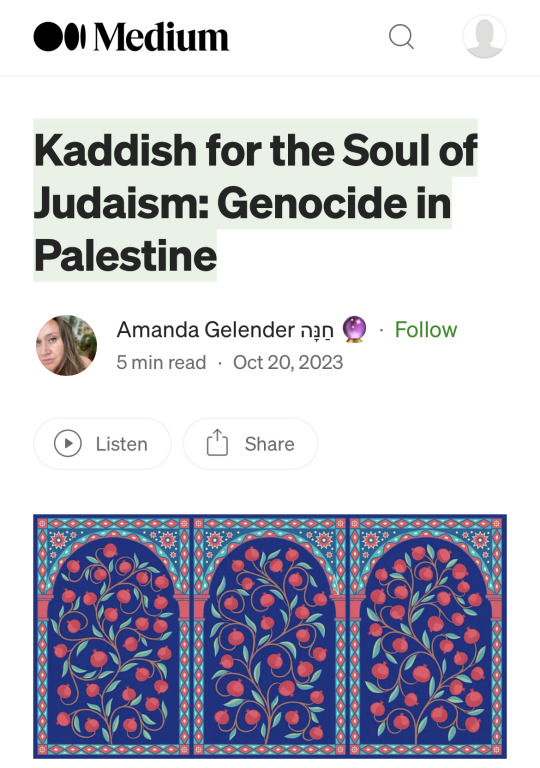


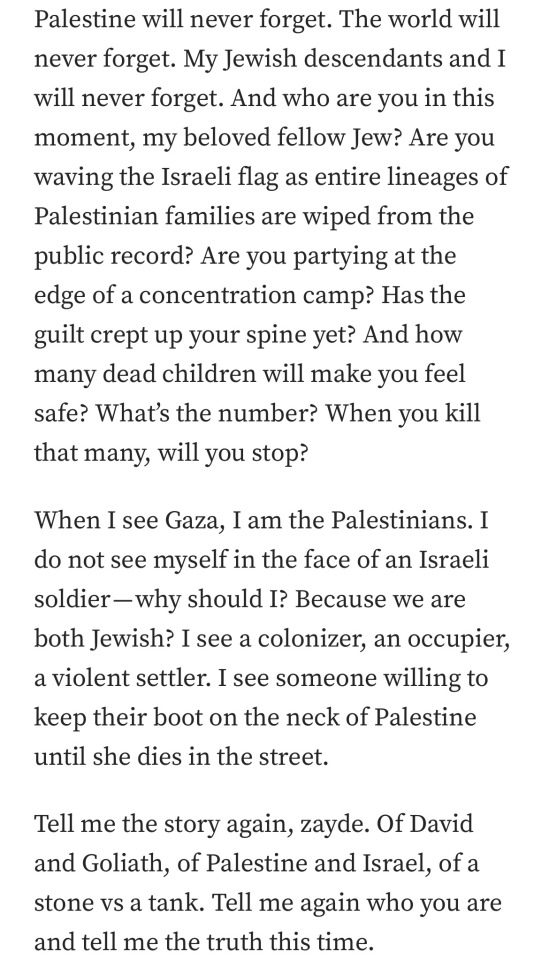
#i only posted an excerpt#the whole article is worth reading#free palestine#palestine#jews for palestine#free gaza#gaza#anti zionisim#anti zionist jew#kaddish for the soul of judaism
18K notes
·
View notes
Text
Blog Posting Site - felixarticle.com
You will find article post, guest posts, and blog posting sites on Google. check felixarticle.com to a better posting experience.

#blog posting#guest blogging#article posting#guest posting#Free blog posting#Free guest blogging#Free article posting#Free guest posting
0 notes
Text
i'm begging you guys to start pirating shit from streaming platforms. there are so many websites where you can stream that shit for free, here's a quick HOW TO:
1) Search for: watch TITLE OF WORK free online

2) Scroll to the bottom of results. Click any of the "Complaint" links

3) You will be taken to a long list of links that were removed for copyright infringement. Use the 'find' function to search for the name of the show/movie you were originally searching for. You will get something like this (specifics removed because if you love an illegal streaming site you don't post its url on social media)

4) each of these links is to a website where you can stream shit for free. go to the individual websites and search for your show/movie. you might have to copy-paste a few before you find exactly what you're looking, but the whole process only takes a minute. the speed/quality is usually the same as on netflix/whatever, and they even have subtitles! (make sure to use an adblocker though, these sites are funded by annoying popups)
In conclusion, if you do this often enough you will start recognizing the most dependable websites, and you can just bookmark those instead. (note: this is completely separate from torrenting, which is also a beautiful thing but requires different software and a vpn)
you can also download the media in question (look for a "download" button built into the video window, or use a browser extension such as Video DownloadHelper.)
#for adblocking--ublock origin is my favorite but adblocker plus is also popular#also i once again highly recommend using firefox especially on mobile#to enable adblock on firefox mobile just click 3 dot menu > addons > addon manager > enable uBlockOrigin#that's for android i assume it's similar for iOS#update it is NOT similar for iOS bc Apple hates you. i'll write another post later#anyway. PLEASE USE AN ADBLOCK ALL THE TIME (except for specific websites you want to support)#your internet browsing experience will be so enormously improved#also on firefox if you want to get past a paywall click the 'Toggle reader view' button as soon as the page loads#(it's on the right of the taskbar. a little rectangle with horizontal lines)#works for most news sites by showing you the webpage text that is hidden under the 'you've run out of free articles' popup#doesn't work for everything but it's worth a shot
83K notes
·
View notes
Text
Empower Your Content: Free Article Posting with AAJJO

Are you looking to boost your online presence and share your knowledge with a wider audience? Look no further because AAJJO Business Solutions is here to help you. With a domain rating of 74, domain authority of 43, and page authority of 49, we are a trusted platform for businesses and individuals alike. Our latest offering, the FREE Guest Posting Feature, allows you to expand your reach and connect with a broader audience. In this article, we'll explore the benefits of guest posting and how AAJJO can take your content to the next level.
Why Guest Blogging Matters?
Guest blogging, or guest posting, is a powerful content marketing strategy that offers numerous advantages. It's a win-win situation for both the guest author and the hosting website. Here's why it matters:
Expanded Reach: By publishing your content on other websites, you tap into their existing audience. This means more eyes on your content and a chance to attract new readers, customers, or followers.
Backlinks and SEO: High-quality backlinks are essential for improving your website's search engine ranking. Guest posts that link back to your site can boost your SEO efforts, especially when posted on sites with high domain authority like AAJJO.
Credibility and Authority: When your content appears on reputable websites, you establish yourself as an expert in your field. This builds trust and credibility with your target audience.
The Power of AAJJO Guest Posting
AAJJO's FREE Guest Posting Feature is designed to help you leverage all the benefits of guest blogging. Here's what you can expect when you choose us:
High Domain Rating: With a domain rating of 74, AAJJO offers you an authoritative platform to showcase your expertise.
Quality Backlinks: Guest posts on AAJJO provide powerful backlinks to your website, contributing to your SEO efforts and online visibility.
Targeted Audience: Our audience comprises diverse industries and interests, ensuring your content reaches the right people.
User-Friendly Submission: Submitting your guest post is easy and hassle-free. We have a streamlined process that lets you focus on your content.
Engagement and Exposure: Our platform encourages reader engagement, and your content is promoted across our social media channels and newsletters.
How to Get Started
Getting started with AAJJO's FREE Guest Posting Feature is simple:
Visit our website and create an account if you haven't already.
Log in and navigate to the "Submit Guest Post" section.
Follow the guidelines and submit your well-crafted guest post.
your content will be published, providing you with valuable exposure.
Final Thoughts
In the world of online marketing, guest blogging is a potent tool. It allows you to share your knowledge, build your online reputation, and boost your website's SEO. AAJJO Business Solutions, with its impressive domain rating, domain authority, and page authority, is the perfect platform for your guest posting needs. Start leveraging the power of AAJJO's FREE Guest Posting Feature today and watch your online presence soar! Join us in the journey of expanding your reach and increasing your online influence. Submit your guest post with AAJJO Business Solutions and take your content marketing to the next level.
#free guest post site#free article posting#free guest post site list#free guest post#free guest post sites#free guest posting sites#guest blogging#submit free guest post#blog post submission#article marketing
0 notes
Text
Brown University students are launching an indefinite hunger strike for Palestine
they are asking for their university to divest from companies profiting from the genocide in gaza and openly call for a ceasefire and will not eat until the university governing bodies hears and considers a divestment resolution. if you are not familiar with the physical toll a hunger strike takes on the body, it might be worth looking up to get a better sense of what a significant action these students are taking. the university's highest governing body is having their first meeting of 2024 on february 8-9th so let's rally around them to muster even more pressure on brown university.
brown university contact page: let's state our support for these students and let brown university know the world will be watching what happens next!
additional reading: coverage of this story in the university's student news paper - get to know some of the hunger strikers
#a lot of hunger strikes are effective simply because it looks really bad if certain people die under your care because you were denying#them something they believed so important that they'd stake their life on it. and i think students who are in care of a school#are very much in a position to hunger strike powerfully.#there are even more articles on the brown daily herald that are worth reading i think shorter posts tend to get more traction but#i might make a follow up later#free palestine#free gaza#brown university hunger strike#hunger strike
4K notes
·
View notes
Text
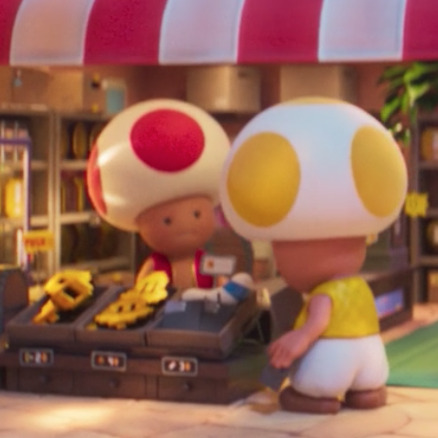





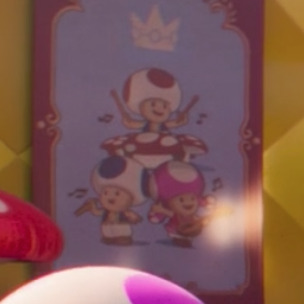
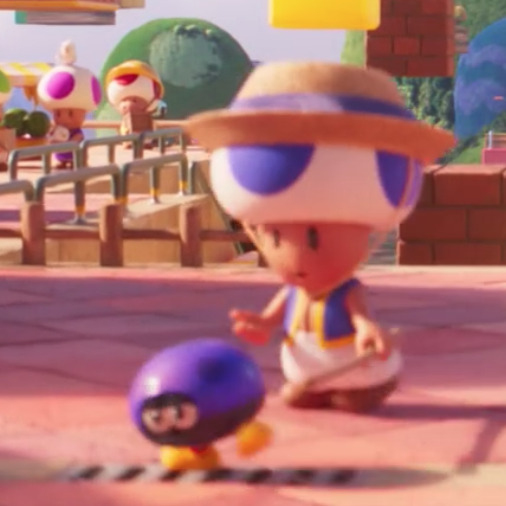
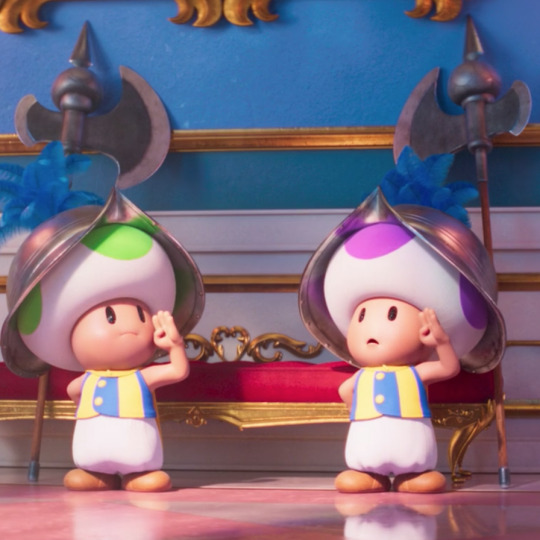
#look I know this is one of the dumbest things I've ever posted and reads like a corporate buzzfeed article#but consider: I genuinely am curious please tell me#mario movie#super mario bros#the super mario bros movie#super mario brothers#brain is latching on to Toad society tonight for some reason#It just looks so cozy. 90% of them are just hanging around with free time to spare#getting groceries and chatting with friends#Like dang... Peach be good at her job. That is an optimal society if I've ever seen one.#polls
177 notes
·
View notes
Note
Also, the idea that we might not (WON'T) have to compromise on getting our first female president by her being a conservative republican 😍
#post-it-free#ask#politics for ts#kamala harris 2024#i mean. yeah.#britain has had three female PMs#and they were... margaret thatcher theresa may and fucking liz truss#this is a WILDLY enormous upgrade in the First Female Head of State stakes#also read the article it's great
94 notes
·
View notes
Note
They pointed a gun at Aaron. When there was a self immolation in December, the authorities spoke about it as if it was a form of antisemitism.
I have said it before. I will say it again.
It is an act of despair and feeling like nothing else you can do will be heard. Nobody burns themselves alive out of hatred.
Nobody.
I truly believe it was an act of grief. it was an act of fury. but i want to stress that it was not an act of hopelessness. like i said before, it was not just suicide, it was a calculated political act made by a determined man of sound mind and body who decided to use his death to send a message. he burned himself in front of the embassy in uniform because he knew that in the eyes of the US government, his life was worth more than the lives of Palestinians. His death was a deliberate attempt to call attention to the deaths of the thousands upon thousands of innocent people in Gaza. the point is that every death an inhumane brutal unconscionable horrific end to a real human life. the point is to disturb. the point is to be seen and heard and felt. he died screaming for Palestine.
like i said in another post, I took a class violent and nonviolent protests as an undergrad, and we talked a LOT about self immolation, and the work / thought / motives / grief / anger that goes into something like that. I’m gonna link a few articles if anyone is interested, I know it’s a really heavy subject but I also think its important to understand the role the act of self immolation has played in the history of protest:
this is about religious activists (both quakers and buddhists) who self immolated in protest of the Vietnam War
this is about the terminology we use to talk about self-immolation (specifically about the self immolation of tibetans in Protest of Chinese occupation) and about the objectives of political self immolators
and lastly, i am telling EVERYONE to read Weird John Brown: Divine Violence and the Limits of Ethics by Ted A. Smith. it’s not about self immolation, but it is about the use of violence in systemic oppression and resistance and deals with the question of Who Defines What Violence Is (spoiler alert: the state defines what violence is, and the definition will always stretch to include the actions of the resistance and exclude the actions of the state). it is a really in depth and succinct examinations of the mechanisms of state sanctioned violence, and its HUGELY relevant to everything that’s been happening. PLEASE read it. everybody should read it. i don’t have a link to a pdf but im sure you can find one, or get it from a library or bookstore. it’s worth having, honestly. go read it.

#free palestine#self immolation#aaron bushnell#abolish the police#okay idc if you skim what I wrote in this post but it would b cool if u could reblog this post for the links cause i do want people to see#and maybe read the articles / check out the book even if they don’t read what i have to say#what i have to say isn’t actually as important
109 notes
·
View notes
Text
Update! A kind soul over on twitter let me know that there are pretty reliable AI art checkers online, that have been developed by people specialising in AI and machine learning!
An NYT article also talks about the pros and cons of a number of them.
I tested all the 3 free open access sites (Illuminarty, Optic AI or Not, Umm-Maybe) and only Illuminarty and Optic AI or Not gave consistent results on both art and photographs.
I'll put the links below so anyone can go and check for whichever art they want to (download the original images from tumblr posts, and upload them)
https://www.aiornot.com/#home
https://app.illuminarty.ai/
These are the results :

Optic flagged it as AI immediately.
But Illuminarty had very interesting aspect : when I uploaded the full image, AI probability was 10%. but, on cropping out the bottom of the image (jacket) the probability jumped to 73.9%
This is consistent with my original comment on the art here

My limited understanding of these programs indicate that they scan the entire image including all the individual pixels. AI programs like Stable Diffusion, Mid Journey, DallE all leave signal artifacts when they process an image, which is then left on the final pic generated!
Compare these two @/skykashi original arts, that are immediately flagged as human made.

And now I get to my favourite AI art bro in the fandom @madasama! I commend you for admitting that you not only use AI, but are proud of producing a large number of "real" arts in such a short time!
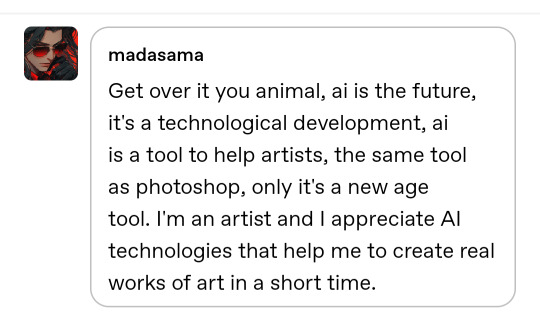
Here's your "art"s results!!

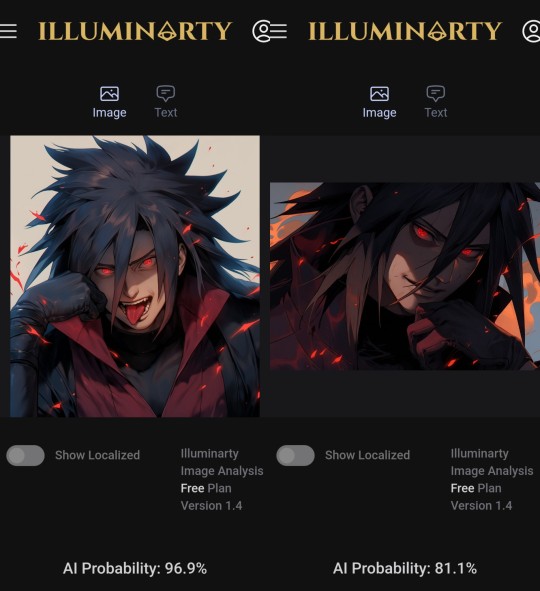
@elhnrt made a far more detailed and organised post about this specific weirdo, feel free to check it out!
I will be using fandom tags on this particular post so that it has a broader reach. Especially for genuine digital artists and art lovers. Save the links, and always keep an eye out for AI, it's everywhere these days.
#Naruto#Fanart#Digital art#Anti AI#say no to ai art#Fandom#Tumblr#AI resources#Idk if tumblr is gonna eat up this post on the tags#But it's worth a try#Also since I've been accused of trying to spread misinformation without 'solid proof'#Here's an attempt from verified widely used websites that anyone can access free of cost#The NYT article was a great resource#It talked about the pros and cons and limitations of each site#Worth a read tbh#These AI checkers are not 100% guaranteed to give accurate results all the time#It's best to check with multiple AI flaggers and compare results#And also with context clues like the artstyle skill set and frequency of posting arts of the acc in question
378 notes
·
View notes
Text
Submit Your Free Blog | Guest Blog Posting Site - Crivva
Crivva is a trending social network for business. At crivva you can post & submit your free blogs. Join #crivva and post your free blog today.

#crivva#free blog posting#crivva social#free blog submission#free press release submission#free pr submission#free article posting#free forum posting
0 notes
Text
Because tuatara are very long lived - between 100 and 200 years by most estimates […] - the founding of Aotearoa/New Zealand as a modern nation and the unfolding of settler-wrought changes to its environment have transpired over the course of the lives of perhaps just two tuatara [...].
---
[T]he tuatara (Sphenodon punctatus) [...] [is] the sole surviving representative of an order of reptiles that pre-dates the dinosaurs. [...] [T]he tuatara is of immense global and local significance and its story is pre-eminently one of deep timescales, of life-in-place [...]. Epithets abound for the unique and ancient biodiversity found in Aotearoa/New Zealand. Prized as “Ghosts of Gondwana” (Gibbs 2008), or as denizens of “Moa’s Ark” (Bellamy et al. 1990) or “The Southern Ark” (Andrews 1986), the country’s faunal species invoke fascination and inspire strong language [...]. In rounded terms, it [has been] [...] just 250 years since James Cook made landfall; just 200 years since the founding of the handful of [...] settlements that instigated agricultural transformation of the land [...]. European newcomers [...] were disconcerted by the biota [...]: the country was seen to “lack” terrestrial mammals; many of its birds were flightless and/or songless; its bats crawled through leaf-litter; its penguins inhabited forests; its parrots were mountain-dwellers; its frogs laid eggs that hatched miniature frogs rather than tadpoles [...].
---
Despite having met a reassuringly temperate climate [mild, oceanic, comparable to western Europe], too, the newcomers nevertheless sought to make adjustments to that climate, and it was clear to them that profits beckoned. Surveying the towering lowland forests from the deck of HMS Endeavour in 1769, and perceiving scope for expansion of the fenland drainage schemes being undertaken at that time in England and across swathes of Europe, Joseph Banks [botanist on Cook's voyage] reported on “swamps which might doubtless Easily be drained” [...]. Almost a century later, in New Zealand or Zealandia, the Britain of the South, [...] Hursthouse offered a fuller explication of this ethos: The cultivation of a new country materially improves its climate. Damp and dripping forests, exhaling pestilent vapours from rank and rotten vegetation, fall before the axe [...]. Fen and march and swamp, the bittern’s dank domain, fertile only in miasma, are drained; and the plough converts them into wholesome plains of fruit, and grain, and grass. [...]
[The British administrators] duly set about felling the ancient forests of Aotearoa/New Zealand, draining the country’s swamps [...]. They also began importing and acclimatising a vast array of exotic (predominantly northern-world) species [sheep, cattle, rodents, weasels, cats, crops, English pasture grasses, etc.] [...]. [T]hey constructed the seemingly ordinary agronomic patchwork of Aotearoa/New Zealand's productive, workaday landscapes [...]. This is effected through and/or accompanied by drastic deforestation, alteration of the water table and the flow of waterways, displacement and decline of endemic species, re-organisation of predation chains and pollination sequences and so on [...]. Aotearoa/New Zealand was founded in and through climate crisis [...]. Climate crisis is not a disastrous event waiting to happen in the future in this part of the world; rather, it has been with us for two centuries already [...].
---
[T]he crest formed by the twinned themes of absence and exceptionalism [...] has shaped this creature's niche in the western imagination. As one of the very oldest species on earth, tuatara have come to be recognised [in Euro-American scientific schemas] [...] as an evolutionary and biodiversity treasure [...]. In 1867, [...] Gunther [...] pronounced that it was not a lizard at all [...] [and] placed the tuatara [...] in a new order, Rhynchocephalia, [...] igniting a frenzy of scientific interest worldwide. Specifically, the tuatara was seen to afford opportunities for "astonished witnessing" [...], for "the excitement of having the chance to see, to study, to observe a true saurian of Mesozoic times in the flesh, still living, but only on this tiny speck of the earth [...], while all its ancestors [...] died about one hundred and thirty-five million years ago" [...]. Tuatara have, however, long held special status as a taonga or treasured species in Māori epistemologies, featuring in a range of [...] stories where [...] [they] are described by different climates and archaeologies of knowledge [...] (see Waitangi Tribunal 2011, p. 134). [...]
While unconfirmed sightings in the Wellington district were reported in the nineteenth century, tuatara currently survive only in actively managed - that is, monitored and pest-controlled - areas on scattered offshore islands, as well as in mainland zoo and sanctuary populations. As this confinement suggests, tuatara are functionally “extinct” in almost all of their former wild ranges. [...] [Italicized text in the heading of this post originally situated here in Boswell's article.] [...] In the remaining areas of Aotearoa/New Zealand where this species does now live [...], tuatara may in some cases be the oldest living inhabitants. Yet [...] if the tuatara is a creature of long memory, this memory is at risk of elimination or erasure. [...] [T]uatara expose and complicate the [...] machineries of public memory [...] and attendant environmental ideologies and management paradigms [...].
---
All text above by: Anna Boswell. "Climates of Change: A Tuatara's-Eye View". Humanities, 2020, Volume 9, Issue 2, 38. Published 1 May 2020. This article belongs to the Special Issue Environmental Humanities Approaches to Climate Change. [Bold emphasis and some paragraph breaks/contractions added by me. Text within brackets added by me for clarity. The first paragraph/heading in this post, with text in italics, are also the words of Boswell from this same article. Presented here for commentary, teaching, criticism purposes.]
#i posted commentary about this article in 2020 right after it was first published but i did a sloppy job presenting and discussing it#some might be familiar with boswells 2015 article on longfin eels or her article the stoat free state on weasels in aotearoa#basically she writes on british imperial environmental imaginaries#how settlement tries to reshape a colonys landscape in idealized english image of domesticated home replacing native species with introduce#ecology#abolition#imperial#colonial#landscape#paleo#aotearoa#indigenous#multispecies
75 notes
·
View notes
Text
Mokumokuren
Birds of different feathers flock together
Noticed online by head-hunting publishers, Mokumokuren hasn’t waited very long before polarising the attention of Japanese readers. With strange The Summer Hikaru Died, horrific bromance dealing with body dispossession, the mangaka signs a series of sophisticated oddity, that sets itself apart from the predictability of current fantasy productions.
Interview by Fausto Fasulo. Original translation: Aurélien Estager. English translation: “Keikotwins”. Bibliography: Marius Chapuis. Thanks: Camille Hospital & Clarisse Langlet (Pika), Yuta Nabatame, Mayuko Yamamoto & Mana Kukimoto (Kadokawa), Chiho Muramatsu (Tohan)
(T/N: Interview given to ATOM in winter 2023; 2 volumes were out in French.)
-
In an interview given to the CREA website in November 2022, you confided inventing stories since very young. Did your first fictions resemble the ones you draw nowadays?
It’s true that there are quite a lot of common points between the stories I imagined when I was a child and the ones I tell nowadays in my mangas. Especially a specific motif, that has been haunting me since the time when I wasn’t really aware of the world surrounding me: the presence amongst us of “non-human” beings, that nonetheless have a perfectly normal, ordinary appearance…
And how was this “obsession” born?
Precisely identifying the origins is complicated, my memories are too blurry, I think… What I can tell you is that I’ve always been fascinated by “creatures”. For example, I remember being very impressed by Peter Jackson’s bestiary in the Lord of the Rings trilogy. By the way, still in a fantasy register, I am also a big fan of Harry Potter adaptations… (She thinks.) And I’ve always liked yōkai stories, you know. I think that what I like in all these mythologies is the idea of species classification: each has its own characteristics – physical, biological – its own way to apprehend its environment.
In Japan, yōkai are integral part of regional folklore. Did the place you grew up in have some specific beliefs?
I was born and grew up in Tokyo, and, as you must know, yōkai are mostly associated with rural areas. I was thus never really bathed in this type of regional fantasy folklore. There are all kinds of yōkai and we can perhaps see in some more contemporary urban legends the echo of certain past beliefs? (She thinks.) I am a bit frustrated, because I believe that I could remember a legend that would have impacted me, but nothing comes to mind immediately, sorry!
You have already said so in an interview and it’s quite obvious when reading your work: you are a big amateur of horrific fiction. What has been your first contact with the genre, all medium included?
It was television that introduced me to horror: special shows, television films, series, I was watching these programs with a mix of fear and enthusiasm, a confused sensation that particularly delighted me! (She thinks.) And amongst all the aired shows, I will remember two titles: Hontō ni atta kowai hanashi and Kaidan shin mimibukuro*.
* Inspired by the homonymous manga magazine published by Asahi Shimbun, Hontō ni atta kowai hanashi (lit. “Scary stories that really happened”) is a series produced by Fuji Television that has been airing more or less weekly since 2004. Derived from literary material (a series of compilations of hundreds of short stories by Hirokatsu Kihara and Ichirō Nakayama, published from 1990 to 2005) Kaidan shin mimibukuro is a series made of several short movies depicting ghost stories based on real testimony.
Did you read horror mangas when you were young?
Let’s say that I was more interested in live-action productions. Nowadays, I obviously appreciate some horror manga authors, without pretending to be any expert in the subject. For example, I like Junji Itō’s work, but I am far from knowing it for a long time… (She thinks.) I could also talk about Shigeru Mizuki, who I also appreciate a lot.
The mechanics of fear aren’t the same in occidental and oriental fictions. You like American horrific productions – like Ari Aster movies – as much as ones from Japanese origin – you notably quote Ichi Sawamura novels and Kōji Shiraishi feature films. Can we say that you are tying these two perspectives with The Summer Hikaru Died?
My relationship with horror is more imbued with oriental sensitivity. But what I find remarkable in occidental horrific productions is work on image. In The Shining like in Ari Aster movies, for example, there is real research made on frame composition and choice of colours. I also try to follow this aesthetic reflection in my work as a mangaka.
In Ari Aster’s work, beyond the very precise staging, there is this permanent desire of ambiguity. Do you try to dig this same equivocal trench?
Absolutely. I try to tell complex feelings as well in The Summer Hikaru Died, like fear dyed with nostalgia or attachment, repulsion mixed with fascination, with attraction…
How do you “sort out” the shots that inspire you in cinema?
I don’t draw while freeze-framing during specific scenes. I would always rather watch a movie as a “focussed” spectator. However, I pay a lot of attention to the way the director composes their frame. I sometimes take some notes, but I most often simply keep it in a corner of my mind.
Could you tell us when and how the story and characters of The Summer Hikaru Died appeared to you? Have they matured a long time within you?
I’ve started thinking about this story when I was preparing university entrance exams. I was aspiring to join an art uni, and I was drawing every day. I can’t really say I made my characters “mature”: back then, I wasn’t thinking that the drawings I was making would one day end up being published, way less being serialised! I innocently created characters close to me, without guessing that one day they’d become manga protagonists.
One of your foundational reads was Sui Ishida’s Tokyo Ghoul manga. Can you tell us how you discovered it and what effect it had on you?
I don’t really remember how I discovered this series, but what I know is that I became crazy about it at first read. What I liked – and what I still like – is this idea of telling a story that confronts humans to these “different” beings while following the point of view of a character that represents alterity. Beyond this strictly dramatic aspect, Sui Ishida’s storyboarding and character design have had a strong impact on my work. However, I want to add that Tokyo Ghoul isn’t the only title I took inspiration from, I obviously have other references…
Do you do a lot of researches to define the design of your characters? You seem to draw them easily, in a very natural gesture…
I haven’t spent a long time defining my protagonists. First, there are few in the manga, then, they evolve in a rather realistic universe. My goal was rather simple: they had to look believable in the reader’s eyes. I wanted people to be able to imagine crossing them in the street, you see?
It’s after seeing illustrations posted on social media that depicted the future characters of The Summer Hikaru Died that the publishing department of the Young Ace Up magazine noticed you. How have you reacted when approached?
I was very surprised, because I absolutely wasn’t trying to become a mangaka. I would have never projected in such a future, you see. And, very honestly, if they hadn’t suggested working on this series, I don’t think I would ever had pushed the doors of a publishing house… I am then very thankful towards the persons who have allowed me to enter.
And what would you have done if you hadn’t been solicited?
Back when I’ve been contacted, I was considering – still vaguely – working in the video games field. But I wasn’t really proactive, I wasn’t contacting anyone, wasn’t sending resumes…
Did you want to do chara-design?
Why not, yes. What I like in video games is the range of possibilities they offer. You can then create an entire universe and this is rather exhilarating.
So you’re a gamer…
I have dropped my controller since I’ve started drawing manga. But yes, when I had more time, I played rather regularly, especially Nintendo productions…
Even if you play rather little nowadays, do video games influence your work?
I can’t say whether it really is an influence, but the Undertale game has left a big mark on me. I felt its creator’s strong will to surprise players, to make them feel unprecedented sensations…
Horror manga only relies on art and storyboard to provoke fear, whereas cinema and video games can also rely on sound. Is it from this observation that you have decided to particularly work on your sound effects?
Absolutely. I have thought a lot about the way to introduce and stage sound in The Summer Hikaru Died. The sound effects that you can find in the manga are indeed the result of this approach.
In an interview given to the Realsound website, you mention the use of the シャワシャワ (“shawa shawa”) sound effect. Knowing that occidental readers are way less sensitive to these graphicoustic details, can you explain its meaning?
“Shawa shawa” expresses the song cicadas make in western Japan. It’s a very special noise because in the different regions live different species that make specific sounds. So when I choose this specific sound effect, I convey a geographic and temporal piece of information to the reader, who can then guess the location and season the action takes place in. (She thinks.) When using this sound – that we especially find in the beginning of the manga – my goal was to play with silence, particularly when the song stops. I thus had the idea of representing this sound effect with an easily readable font, so the reader would make no effort to decipher it, as if the sound was asserting itself naturally, you see? I hoped to suggest a saturation they couldn’t avoid and that, when it’d stop, would immerse them in absolute silence.
The Summer Hikaru Died transcribes very well this particular atmosphere of Japanese summers…
Yes, I really wanted to signify this languor in my manga. And the cicadas’ song we discussed earlier contributes to creating this atmosphere: it’s an overwhelming sound, sometimes irritating, you cannot escape from in summer – Japanese readers obviously know what I’m talking about. (She thinks.) I also gave special attention to shadows: summer light being very bright, shadows are very sharp, very deep.
Do digital tools allow you to get this result more efficiently than traditional?
I work on Clip Studio Paint, and it’s true that it sometimes allow me to save time. Consider the work on shadows: I never apply solid black because I like saturating space with hatches and, with digital tools, I can obtain the desired result faster because I can duplicate each of my lines.
Your use of hatches is sometimes reminiscent of Shūzō Oshimi’s…
I don’t know his mangas very well, but it’s funny that you mention him because I recently read his latest series, Okaeri Alice. In any case, I really like his style and I perfectly understand how you can bring his universe and mine together.
The Summer Hikaru Died relies on the concept of body dispossession, that obviously takes back to the Body Snatcher novel by Jack Finney and its movie adaptations. Did you think about it?
I don’t know this book very well, but I know its theme has been approached often, especially in movies. As I was saying at the beginning of this interview, my idea was to adopt the point of view of a non-human and tell his indecision, his moral questions…
We also find this idea in Hitoshi Iwaaki’s Parasite…
I haven’t read the manga fully, but I’ve watched the anime adaptation that was released a few years ago (R/N: in 2014). I remember rather liking it, even if I think I offer something different with The Summer Hikaru Died. What interests me is sounding the inwardness of my non-human character out and expose all his dilemmas. What is his place amongst men? Is he legitimate in our world? Here is the type of questions that pushed me.
One of the impacting scenes of volume 1 of The Summer Hikaru Died is the one when Yoshiki penetrated Hikaru’s body by shoving his arm into his torso. It’s a sequence that is both very sensuaI – to not say sexuaI – and also very horrific. How did you get this idea?
I wanted to put the readers in an uncomfortable position. A stressful situation that could take several forms because, according to your sensitivity, you can feel very different emotions in front of this scene: sexuaI arousaI, fear or disgust. For me, it was supposed to put the reader in some kind of catatonia, you see?
Do you chat a lot with your tantō, especially around these slightly “complicated” scenes?
I have free rein, you know, I can draw everything I want. My editorial supervisor has never asked me to temper some sexuaIIy connotated parts. My discussions with him don’t revolve around this kind of things, but rather around the structure of the scenario itself: where to place this scene in the narration? Is it better to put this sequence before this other one? Nowadays, I am more at ease with all the scripting layout but, at the beginning, I needed support.
What allows you to get, from a dramatic point of view, the mix between bromance and horror?
I wanted to show the differences in sensitivities and values between a human being and an “other than human”, and tell the misunderstandings this can cause when both meet. When Yoshiki “scratches” under the appearance of the one who is supposed to be his best friend, it creates a first point of conflict in the story. I then hoped to make his relationship with Hikaru – or rather with the “entity” that pretends to embody him – a kind of undefinable bond, that wouldn’t be friendship, nor love.
Do you know today where this strange relationship between your two heroes will lead you?
I know more or less how all of this will evolve, yes. I have decided on my story’s general plot since the beginning. I can only tell you that The Summer Hikaru Died won’t be a long series.
How do you explain the almost instant public plebiscite of your series in Japan? You perhaps cannot have perspective on it but, in a saturated publishing landscape, you have managed to stand out…
Hm… Indeed, I don’t really have precise explanations to give you about this success. Maybe the covers’ design has been in favour of the manga? I asked the person in charge of graphics to make sure that the visuals would be noticeable in bookstores. That’s why the books have this monochrome aspect, with the title discreetly placed. I didn’t want obvious advertisement banners, but something simple, like this blue background for the first volume, on which the character stands out. I also wished to create contrast between the jacket’s and the inner cover’s drawings. I thus had requirements that didn’t quite go alongside what we can nowadays see on the shelves of Japanese bookstores.
#the summer hikaru died#hikaru ga shinda natsu#/long post#I'm not a native eng speaker so excuse mistakes!#the fr version has fancy words that I simplified for the eng translation#Feel free to ask any question!#The og article had manga illustrations with funny comments as legends + a short analysis of the manga's narration that I didn't include#The og title was 'Qui se dissemble s'assemble'#which is a play of words saying the opposite of idiom 'Qui se ressemble s'assemble' lit 'who look alike go together'#so I went for a silly equivalent lmao
54 notes
·
View notes
Text
“As alleged in the complaint, the participants in the cobalt market intentionally use a murky supply chain to obscure the extent to which they rely on forced labor,” Rao wrote in the ruling. “This allows the Tech Companies and their suppliers to avoid formal association with forced labor, yet everyone in the venture knows the global supply chain includes cobalt procured by forced labor.”
Terry Collingsworth, a lawyer for the plaintiffs, told Reuters that his clients might appeal further. The decision Tuesday proves that there is a “strong incentive to avoid any transparency with their suppliers, even as they promise the public they have ‘zero tolerance’ policies against child labor.”
#congo#free congo#congo genocide#democratic republic of the congo#apple lawsuit#google lawsuit#was looking up about the mar. 10 rafah invasion and this was recommended article. so wanted to post before going to bed
57 notes
·
View notes
Note
"Also are we going to pretend that there wasn't a like 5-year period where 'points out logical fallacies (annoyingly)' wasn't one of the canonical traits of le toxic STEMbro?"
Okay but most of those weren't even pointing out real logical fallacies as much as saying "stop saying things that don't fit my script"
Oh sure, most people arguing on the internet are bad at it. This is known, but it's hardy a STEM-only thing. I mean, you're on tumblr - how long does it take to find a proud English major proving that they have no way to understand a text except 'gospel truth' and 'malicious deceptive propaganda'?
#cf that triv post about people who spend all their free time on fandom 'analysis'#but are totally incapable of reading the implicit perspective in a news article#(I really do actively resent the number of people on here for get righteously angry about a text that is in fact agreeing with them#just like with a bit of tact)
24 notes
·
View notes
Text
Stop saying that Reo refers to his dynamic with Nagi as just a business partner, that's not factually true
Or well, it's out of context and only partially true
I keep seeing this argument brought up in nagireo meta as a way to bring ammo to the interpretation that Reo sees their dynamic as transactional while Nagi cares for him as a person, using the Barou scene as a frame of reference, but. As someone who read the whole manga in japanese, fun fact! There's another time where their relationship is brought up with a descriptor before that scene, and it's in fact Reo who refers to Nagi as his partner first. Not a business partner, just a partner. Someone you spend time with.


To be precise, the word he uses is 相棒 ("aibou"), which, second fun fact, is the same word Bachira used to describe his relationship with Isagi (in the scene where he says "I love you, partner". Just stressing that cause I find it amusing lol). In Bachira's case, this word was officially translated as "buddy". It basically means partner/companion/comrade. As you can see, there's no exploitative subtext, unless you're willing to read that into Bachira's line as well.
This scene was in chapter one of episode Nagi, so it's Reo who sets the tone of their buddying relationship. Nagi just follows.

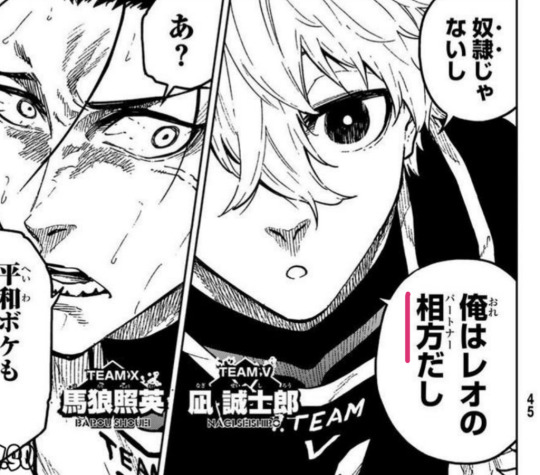
When Barou accuses him of being a mindless slave that only follows Reo's orders then, Nagi's prompt response is to call himself "Reo's partner, not a slave", using the word 相方 ("aikata") this time. As you might have noticed, it's almost the same word! Same first kanji, almost no differences in nuance as far as the meaning goes. This one too means partner, companion.
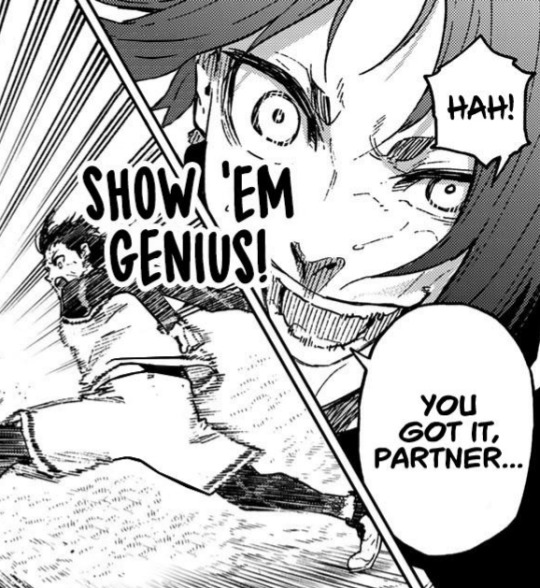

So, where does the confusion come from? Well, the thing is, Reo does call Nagi his business partner, too! A whole total of once, and it made more sense in context. The reason why this got more attention than the line in chapter one, I believe, is because Reo says it shortly after Nagi candidly called him his aikata, so it jumps out more and makes Reo sound so much colder than he is.
But again, context!
Given how Reo's the first to put a friendly label on their relationship, clearly the intent here is not to tell us he secretly only sees Nagi as an asset whose potential he's investing in. More like, this line was in response to this,
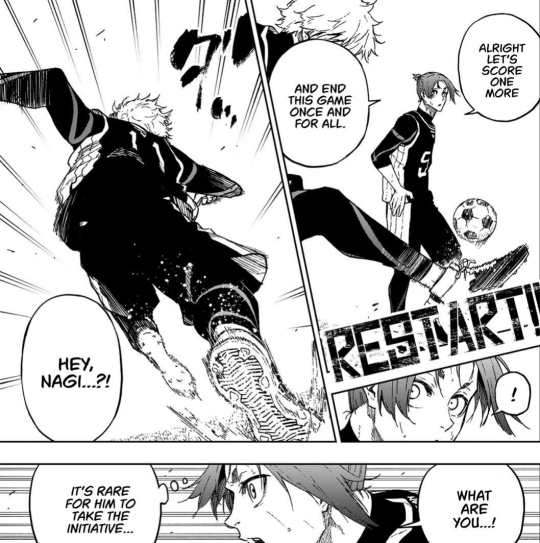
Nagi's ego rearing its head at long last, and him taking the initiative in a play for the first time. Here he calls him his business partner because Nagi's finally rising to meet him as an equal, instead of simply trudging along because of Reo's pushing. It's Nagi who requests an assist, and Reo enthusiastically provides it, and remarks upon it with this term. But, and please note, in all the three different occurrences, no matter the word in kanji, the furigana always spells out "partner", cause that's what's the focus
So please stop saying that Reo doesn't give the same weight to their friendship as Nagi does, that's just untrue. They both obviously care about each other, and their actions show it better than their words, tbh.
I guess one might still overanalyse the fact that they don't use the same exact term for partner, and wonder what the difference is, as one (me) does. This is what I found (with a japanese source for more accuracy):
「相棒」と「相方」の違いとしては、「相棒」には「ひとつの目的を達成するために共に助け合う相手」といったニュアンスがあり、「相方」には「人柄や性格を理解し合いながら、苦楽を共にする相手」といったニュアンスがあります。
Inputting this into a machine translator cause it's 1am and I don't have the brainpower to translate it myself:
The difference between "buddy" and "partner" is that "buddy" (=aibou) has the nuance of "a partner who helps each other to achieve a goal," while "partner"(=aikata) has the nuance of "a partner who understands each other's personality and character and shares hardships and joys.
Which I feel is a much better distinction that makes a lot more sense with their respective motivators/feelings. Reo sees Nagi as the person at whose side he'll be able to win the world cup, thus it makes a lot of sense for him to use aibou. Nagi gave him the confidence to think himself world class despite his father's scorn. He's his partner in crime, so to speak. While Nagi sees Reo as the first person who saw past his weirdness, understood him better than most, and as the companion he can always circle back to and tell him about the joys and hassles hardships he went through
Signed: a pedantic nagireo fan who thinks they're both the same shade of simp
#Nagireo#Nagi seishirou#Mikage reo#Episode nagi#Bllk thoughts#I have been stewing on this for weeks now#I was planning on writing a better post on it#But hey this is what you get#If you want to laugh I could still expand on this topic#Cause when I was digging in my liguistic research hole I found an article#Dissecting how japanese speakers feel about calling their romantic partner aikata#And some of the stuff it said was amusing when you read it through the lenses of nagi calling reo his romantic partner with that word lol#Anyway I'll stop rambling now thanks for reading#They live rent free in my head
115 notes
·
View notes
Text

Follow the news. The Folkwang Museum's cancelling of Anaïs Duplan's exhibition (and still profiting from his work) is not the only institution overreacting preemptively in light of the current crackdown of israel-critical voices on a slippery slope to fascism.
These developments didn't just start with Hamas' attack on Israel of Octobre 7th:
But the political landscape is using its performative solidarity with Israel to restrict fundamental rights more and more especially with the rightwing parties heating up the migration debate again and the Ampel dropping all semblance of a backbone. And they aren't nearly done - keep in mind the upcoming elections where everyone wants a piece of AfD's fascism pie as they are projected to reach majority in three states.
#and these are just the ones i know of. i'm not a journalist nor can i legitimately call myself an activist.#most posts i reblog here are ones that change or enhance my understanding. so imagine the dunkelziffer of things i'm missing.#so feel free to add. tried getting english sources for most but wasn't successful in all of them.#also couldn't find a proper article listing all the banned paroles atp besides excerpts - would love an addition if you can find one#(example: “stop genocide” “from the river to the sea we demand equality” “israel is killing children” - last demo those were all banned)#long post#german stuff#german politics#“not all germany waah waah” “what the boss says is law waah waah” “you're all so ignorant” do you believe your grandpa was innocent too#(metaphorically spoken)
49 notes
·
View notes